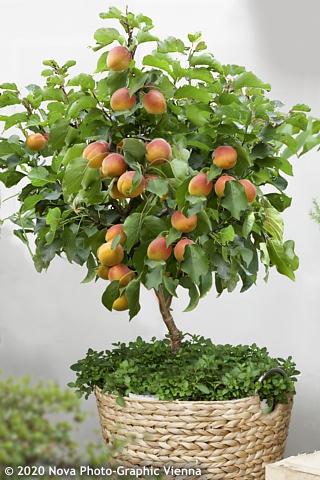Prunus armeniaca ZAKRSLÉ ODRŮDY / DWARF

Prunus armeniaca ZAKRSLÉ ODRŮDY / DWARF
dwarf apricot tree
dwarf apricot tree
| SIZE/TYPE | small tree |
|---|---|
| USUAL HEIGHT | 1-1.5m |
| USUAL WIDTH | 0.5-1m |
| LEAVES | deciduous broadleaf |
| COLOUR OF LEAVES |
 green green |
| LOCATION | full sun |
| USDA zone (lowest) | 5b (down to -27°C) |
| WINTER PROTECTION | |
| FOR ZONE 5+6 |

|
| FOR ZONE 7 |

|
| BELONGS TO CATEGORIES | Fruit trees |
Dwarf fruit trees are excellent choices for those who have small gardens or no garden at all. These miniature plants can be grown in outdoor pots on balconies, patios or roof terraces so you can enjoy the taste of your own, home grown fruit.
Who would not love a fresh and sweet apricot picked off in the middle of summer. Not a garden owner? No problem, dwarf apricots will live in a large pot on a balcony or patio, too. They are all self-fertile so that they don’t need a pollinator which might be a problem to find if located on a city balcony. Apricot trees cannot form a true columnar variety, botanically those which are more slender than the usual trees are called compact apricot trees and we also list them here.
Varieties:
- Kalula Zwerg – dwarf – late variety, small, aromatic and sweet fruit, orange skin, red blushed, matures in August, grows to about 1.5m
- (Nana) Bashful – dwarf – medium late variety, medium-sized, aromatic and sweet fruit, orange-red skin, matures in late July/early August, grows to about 1.5m
- Orange Beauty – dwarf – medium late variety, medium-sized, juicy and sweet fruit, deep orange skin, matures in late July/early August, grows to about 1.5m
- Aprikompakt®
– compact – medium late variety, medium-sized, sweet fruit, deep orange, red flushed skin, matures in late July/early August, grows to about 1.5m, resistant to brown rot
- Garden Aprigold® - dwarf, medium early (mid July), rounded fruit, orange skin, orange flesh, sweet and juicy, upright habit, grows abt. 2m tall and 1m wide
Apricot trees need fertile, medium moist, and warm soil, can be slightly acid or alkaline. If container grown it needs to be fertilized every year with a suitable slow-release fertilizer. Grow them solely in full sun. They do not require or even like pruning but can be trimmed after flowering if necessary. They are hardy in the garden to about -27°C (USDA zone 5b), but on patios they need to be potted in a large container and insulated from the ground with a polystyrene for winter.
Last update 23-03-2020; 05-02-2021
Who would not love a fresh and sweet apricot picked off in the middle of summer. Not a garden owner? No problem, dwarf apricots will live in a large pot on a balcony or patio, too. They are all self-fertile so that they don’t need a pollinator which might be a problem to find if located on a city balcony. Apricot trees cannot form a true columnar variety, botanically those which are more slender than the usual trees are called compact apricot trees and we also list them here.
Varieties:
- Kalula Zwerg – dwarf – late variety, small, aromatic and sweet fruit, orange skin, red blushed, matures in August, grows to about 1.5m
- (Nana) Bashful – dwarf – medium late variety, medium-sized, aromatic and sweet fruit, orange-red skin, matures in late July/early August, grows to about 1.5m
- Orange Beauty – dwarf – medium late variety, medium-sized, juicy and sweet fruit, deep orange skin, matures in late July/early August, grows to about 1.5m
- Aprikompakt®
– compact – medium late variety, medium-sized, sweet fruit, deep orange, red flushed skin, matures in late July/early August, grows to about 1.5m, resistant to brown rot
- Garden Aprigold® - dwarf, medium early (mid July), rounded fruit, orange skin, orange flesh, sweet and juicy, upright habit, grows abt. 2m tall and 1m wide
Apricot trees need fertile, medium moist, and warm soil, can be slightly acid or alkaline. If container grown it needs to be fertilized every year with a suitable slow-release fertilizer. Grow them solely in full sun. They do not require or even like pruning but can be trimmed after flowering if necessary. They are hardy in the garden to about -27°C (USDA zone 5b), but on patios they need to be potted in a large container and insulated from the ground with a polystyrene for winter.
Last update 23-03-2020; 05-02-2021
SIZES and PRICES
GLOSSARY
|







